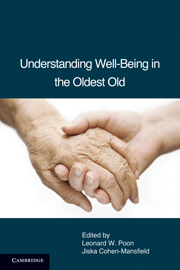Book contents
- Frontmatter
- Contents
- List of Tables
- List of Contributors
- Foreword by Carol D. Ryff
- PART I THEORY: NEW HORIZONS IN WELL-BEING RESEARCH
- PART II PARADISE LOST: BETWEEN TRAUMA AND HAPPINESS
- PART III PATHWAYS AND GATEKEEPERS: MODERATING, MEDIATING, AND PROXIMAL PROCESSES
- PART IV SIGNPOSTING PARADISE: MEASUREMENT OF WELL-BEING
- 15 Culture and Meaning: Strategies for Understanding the Well-Being of the Oldest Old
- 16 The Will to Live as an Indicator of Well-Being and Predictor of Survival in Old Age
- 17 The Measurement of Life Satisfaction and Happiness in Old-Old Age
- 18 Late-Life Psychotherapy: Challenges and Opportunities to Enhance Well-Being in the Oldest Old
- 19 An Integrative Summary and Future Directions in the Study of Well-Being
- Index
- References
15 - Culture and Meaning: Strategies for Understanding the Well-Being of the Oldest Old
Published online by Cambridge University Press: 05 August 2012
- Frontmatter
- Contents
- List of Tables
- List of Contributors
- Foreword by Carol D. Ryff
- PART I THEORY: NEW HORIZONS IN WELL-BEING RESEARCH
- PART II PARADISE LOST: BETWEEN TRAUMA AND HAPPINESS
- PART III PATHWAYS AND GATEKEEPERS: MODERATING, MEDIATING, AND PROXIMAL PROCESSES
- PART IV SIGNPOSTING PARADISE: MEASUREMENT OF WELL-BEING
- 15 Culture and Meaning: Strategies for Understanding the Well-Being of the Oldest Old
- 16 The Will to Live as an Indicator of Well-Being and Predictor of Survival in Old Age
- 17 The Measurement of Life Satisfaction and Happiness in Old-Old Age
- 18 Late-Life Psychotherapy: Challenges and Opportunities to Enhance Well-Being in the Oldest Old
- 19 An Integrative Summary and Future Directions in the Study of Well-Being
- Index
- References
Summary
ABSTRACT
Well-being has been a central variable in understanding the experiences of older people including the oldest old. For subjective well-being cultural understandings and meaning are central. A long standing question has been how to measure well-being within one culture and across cultures. Two major strategies have evolved. The first uses psychometric measures and multivariate analysis to explore different components of well-being. The second is more open-ended using ethnographic and qualitative strategies to elicit dimensions of well-being from the experiences of older people in the contexts in which they live. The promises and difficulties of each methodology are reviewed. The appropriateness of each strategy for diverse contexts and populations of the oldest old are considered.
INTRODUCTION
A prominent and persistent effort of gerontology is directed toward understanding the well-being of older people. The quality of life in a community can be assessed directly through indicators of life expectancy, levels of education, quality of housing, and income. How well-being is experienced and evaluated calls for more subjective measurement. For more than a half a century, researchers have devised scales and alternative strategies for measuring what may well be a gerontological holy grail.
- Type
- Chapter
- Information
- Understanding Well-Being in the Oldest Old , pp. 261 - 280Publisher: Cambridge University PressPrint publication year: 2011
References
- 2
- Cited by



